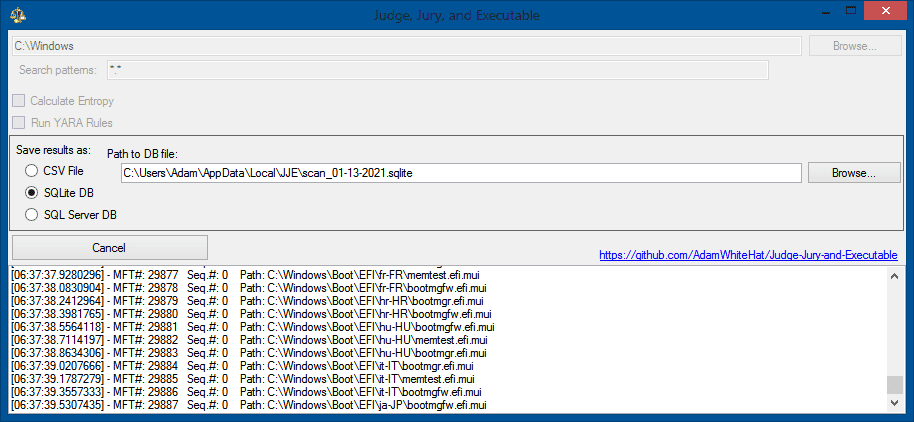
Judge Jury and Executable – A Threat Hunting Forensics Tool
A file system forensics analysis scanner and threat hunting tool. Scans file systems at the MFT and OS level and stored in SQL. Threats and data can be probed by harnessing the power and syntax of SQL.
Features:
- Scan a mounted filesystem for threats right away
- Or gather a system baseline before an incident, for extra threat hunting ability
- Can be used before, during, or after an incident
- For one to many workstations
- Scans the MFT, bypassing file permissions, file locks, or OS file protections/hiding/shadowing
- Up to 51 different properties gathered for every file
- Scan results go into an SQL table for later searching, aggregating results over many scans and/or many machines, and historical or retrospective analysis
- Leverage the power of SQL to search file systems, query file properties, answer complex or high-level questions, and hunt for threats or indicators of compromise
Hunt for viruses, malware, and APTs on (multiple) file systems using by writing queries in SQL.
Allow me to elaborate…
You start with disk or disk images that are potentially dirty with malware, viruses, APT’s (advanced persistent threats), or the like, and then scan them with this tool. (Optionally, and assuming you have the wisdom and foresight to do so, you may wish to scan a known good baseline disk image with this tool first (or later–doesn’t matter). This is certainly not necessary, but can only serve to aid you.) The forensics-level scanning portion of this tool collects a bunch of properties about each file in a file system (or an image(s) of one), and places these properties in a SQL relational database table. The secret sauce comes from being able to threat hunt, investigate, or ask questions about the data through the use of queries, in the language of SQL, against the database that is created. A key feature here was NOT inventing a proprietary query language. If you know SQL, and how to click a button, then you already know how to use this tool like a boss. Even if you don’t, this concept is powerful enough that canned queries (see below) will get you a lot of mileage.
Forensics-level scanning.
Firstly, the tool creates an entry in the database for each record found in the MFT (master file table–its how NTFS does its record-keeping). This bypasses file security permissions, file hiding, stealth or obfuscation techniques, file deletion, or timestamp tampering. These techniques will not prevent the file from being scanned and cataloged.
Rich, high-level data analytics.
Then all operating-system-level properties, data, and meta-data available about each file is collected and augments each entry. As a result of this, even if the file properties from the Framework/Operating System API cannot be accessed due to permissions, file locks (is in use), disk corruption, a zero-byte-length file, or various other reasons, the file will still be recorded, logged and tracked. The entry, however, will simply not contain the information about it that was not accessible to the operating system. Up to 51 different properties may be collected for every file.
For each file, information collected includes:
- SHA256 hash
- MD5 hash
- Import table hash (if it exists)
- MFT Number & Sequence Number
- MFT Create/Modified/Accessed Dates
- Create/Modified/Accessed Dates Reported by OS
- All the ‘Standard’ OS file properties: location, size, datestamps, attributes, metadata
- Is a PE or DLL or Driver?
- Is Authenticode signed?
- Does the X.509 certificate chain verify?
- Custom YARA rules (Lists the rule names that match)
- File entropy
- VirusTotal score
Download
Copyright (C) 2020 Adam White